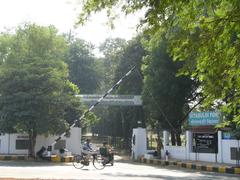Deekshabhoomi Nagpur: Complete Visiting Hours, Ticket Information, and Travel Guide
Date: 14/06/2025
Introduction
Deekshabhoomi, located in Nagpur, Maharashtra, is a monumental symbol of India’s journey toward social justice, spiritual awakening, and cultural transformation. Revered as the site where Dr. B. R. Ambedkar and hundreds of thousands of followers embraced Buddhism in 1956, Deekshabhoomi stands as a beacon for equality and dignity, attracting millions of visitors annually. The architectural marvel of the Dhamma Chakra Stupa, serene gardens, meditation halls, and rich historical exhibits make Deekshabhoomi a must-visit destination for pilgrims, history enthusiasts, and travelers alike. This guide provides detailed information on Deekshabhoomi’s history, architectural highlights, visiting hours, tickets, accessibility, and practical tips for an enriching visit. (Deekshabhoomi.org; NagpurHousing.com; Wikipedia)
Historical Background
Dr. B. R. Ambedkar’s Vision and the Mass Conversion
Dr. Bhimrao Ramji Ambedkar, the architect of the Indian Constitution and a champion for social equality, saw Buddhism as a path to liberation from caste-based oppression. On October 14, 1956, at Deekshabhoomi, he led a mass conversion where over 400,000 followers from marginalized communities joined him in embracing Buddhism. This pivotal event marked the birth of Navayana Buddhism and sparked a nationwide movement for dignity and social reform. (Wikipedia; Deekshabhoomi.org)
Why Nagpur?
Nagpur was chosen for its deep historical links to Buddhism and strategic location in India. The date of conversion, Ashoka Vijaya Dashami, coincided with the 2,550th anniversary of Buddhism, imbuing the event with added spiritual resonance. (Wikipedia)
The Continuing Legacy
Dr. Ambedkar’s untimely death shortly after the conversion did not halt the movement. The Deekshabhoomi site has continued to evolve as a center for Buddhist learning, social activism, and annual commemorations, most notably the Dhamma Chakra Pravartan Din, attracting millions from across India and beyond. (NagpurHousing.com)
Architectural and Cultural Heritage
The Dhamma Chakra Stupa
Deekshabhoomi’s architectural centerpiece is the Dhamma Chakra Stupa, one of Asia’s largest hollow stupas. Inspired by the ancient Sanchi Stupa, it was designed by architect Sheo Dan Mal and constructed over more than two decades, using white marble and Dholpur sandstone to symbolize purity and resilience. The stupa is 120 feet tall and wide, with a hollow interior capable of accommodating over 5,000 people for meditation and prayer. (academia.edu; citybit.in)
Key Features:
- Four Grand Entrances: Oriented to cardinal directions with intricate carvings symbolizing the Four Noble Truths.
- Central Dome: Crowned with a chatra (pinnacle) representing enlightenment.
- Buddha Statue: A central sandalwood Buddha statue, donated by Thai students.
- Surrounding Gardens: Palm-lined avenues and manicured lawns offer tranquility.
Memorials and Museums
Adjacent to the stupa, the Memorial Hall and museum display artifacts, photographs, and manuscripts related to Dr. Ambedkar and the Dalit Buddhist movement, providing historical and educational context to visitors. (indianholidaytrip.com)
Meditation Halls and Library
The complex includes meditation halls for group and individual practice, emphasizing serenity and simplicity, and a library with resources on Buddhism and Ambedkar’s legacy. (thenewsdirt.com; tourtravelworld.com)
Visitor Information
Visiting Hours
- Open daily: 6:00 AM to 8:00 PM.
- Some sources note 24-hour access during major festivals or special events. (yometro.com)
Tickets and Entry Fees
- Entry: Free for all visitors.
- Donations: Accepted for maintenance and cultural activities.
Accessibility
- Wheelchair-accessible ramps and wide pathways.
- Facilities for elderly and differently-abled visitors.
On-site Facilities
- Restrooms and drinking water stations near entrances.
- Shoe stands for secure storage before entering the stupa.
- Shops/stalls selling books, flowers, incense, and souvenirs.
- Security checks during large gatherings.
Dress Code and Etiquette
- Modest attire (shoulders and knees covered).
- Silence or low voices in meditation areas.
- Remove shoes before entering sacred spaces.
- Avoid touching statues or displays.
Getting There
- By Air: Dr. Babasaheb Ambedkar International Airport is 8 km away.
- By Train: Nagpur Railway Station is 5 km from Deekshabhoomi.
- By Road: Well-connected by city buses, auto-rickshaws, and taxis. Parking is available but fills up during festivals.
Events and Activities
Dhamma Chakra Pravartan Din
Held annually on October 14th, this festival commemorates Dr. Ambedkar’s conversion and attracts hundreds of thousands of pilgrims for prayers, processions, and cultural events.
Meditation and Educational Programs
Regular meditation sessions and lectures on Buddhism and social reform are open to all. The on-site library and museum offer educational resources year-round.
Nearby Attractions
- Sitabuldi Fort
- Ambazari Lake and Garden
- Raman Science Centre
- Sonegaon Lake
- Dr. Ambedkar College
These sites are easily accessible from Deekshabhoomi and make for a culturally rich itinerary. (deekshabhoomi.org)
Practical Tips for Visitors
- Early morning visits offer peace and comfort, avoiding crowds and midday heat.
- Plan ahead for large events, especially Dhamma Chakra Pravartan Din, as accommodations and parking fill quickly.
- Hydrate and use sun protection.
- Respect the sanctity of all spaces and support local vendors.
Frequently Asked Questions (FAQs)
Q: What are Deekshabhoomi’s visiting hours?
A: Open daily from 6:00 AM to 8:00 PM; 24-hour access during major events.
Q: Is there an entry fee?
A: No, entry is free.
Q: Are guided tours available?
A: Yes, guides are available on-site or can be arranged through local tourism agencies.
Q: Is the site wheelchair accessible?
A: Yes, with ramps and smooth pathways throughout.
Q: Can I take photographs?
A: Photography is allowed in outdoor areas; restrictions apply inside the main stupa and during ceremonies.
Q: What is the best time to visit?
A: Early mornings or during Dhamma Chakra Pravartan Din for a vibrant experience.
Call to Action
Plan your visit to Deekshabhoomi for an inspiring journey through India’s history of social transformation and spiritual heritage. Download the Audiala app for guided tours, maps, and local insights. Explore more about Nagpur’s historical sites and stay updated on events and travel tips.
Sources and Further Reading
- Deekshabhoomi.org
- NagpurHousing.com
- IndiaAirport.com
- Times of India
- Wikipedia
- thetouristchecklist.com
- citybit.in
- makemytrip.com
- academia.edu
- indianholidaytrip.com
- tourtravelworld.com
- thenewsdirt.com
- yometro.com
- curlytales.com
